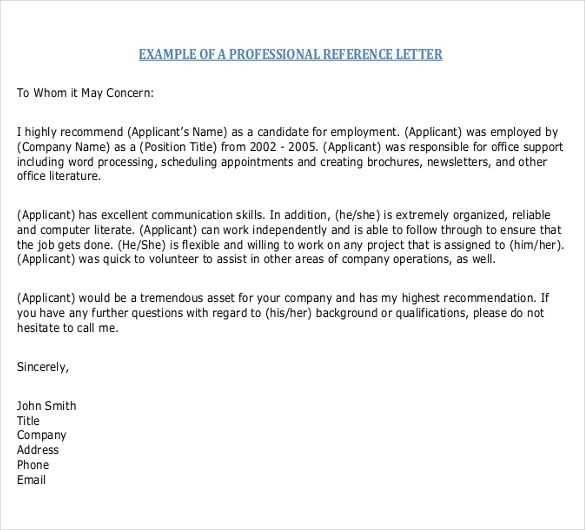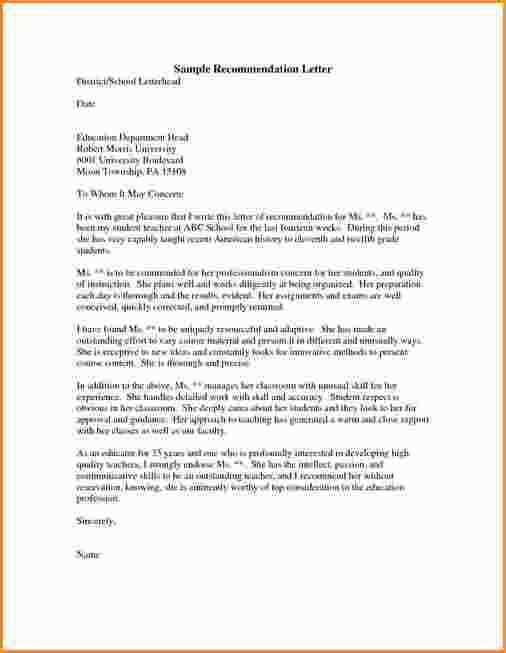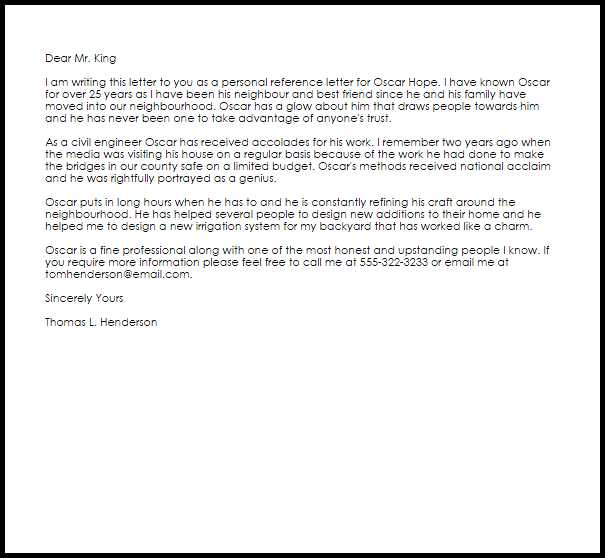Professional recommendation reference letter template

A well-structured recommendation letter can be a pivotal part of a job application. A letter that highlights specific strengths and qualities will resonate much more than a vague, general reference. Focus on showcasing the candidate’s key skills, work ethic, and accomplishments, while also providing context around their role and impact within your organization. A personalized touch can make a significant difference, especially when you reference concrete examples from their time working with you.
Start with a clear introduction: mention your relationship with the individual and the capacity in which you worked together. Avoid generalities about their character and instead, focus on the traits that made them stand out in your experience. Use direct language to describe how their contributions benefited the team, highlighting specific achievements or results wherever possible. This offers a clearer picture to the recipient of the letter, who will better understand the value the candidate brings.
In the body of the letter, provide detailed anecdotes or examples that demonstrate their skills in action. Whether it’s problem-solving, leadership, or technical expertise, these real-world examples will make your letter much more impactful. Be sure to mention any specific projects or initiatives they led or contributed to, and explain how their input positively affected the outcome. This not only shows their capabilities but also provides tangible evidence of their value to your organization.
End the letter by reiterating your strong support for the candidate. Offer a direct endorsement, and invite the recipient to contact you for further information if needed. A final note of confidence in their abilities will reinforce the strength of your recommendation, leaving a lasting impression.
Professional Recommendation Reference Letter Template
To Whom It May Concern,
I am pleased to recommend [Name], who worked as [Job Title] at [Company Name] from [Start Date] to [End Date]. During this time, [Name] consistently demonstrated exceptional skills in [specific skills or responsibilities]. Their contribution to [project or task] resulted in [specific outcomes or improvements].
Here are the key strengths that make [Name] an outstanding professional:
- Leadership: [Name] led a team of [number] in the execution of [specific project], ensuring timely delivery and high-quality results.
- Problem-Solving: [Name] effectively identified issues in [specific process or system] and implemented solutions that improved efficiency by [percentage or specific metric].
- Communication: [Name] maintained clear and productive communication with both internal and external stakeholders, ensuring smooth collaboration and progress.
- Attention to Detail: Their ability to manage complex tasks while maintaining accuracy was crucial to the success of [specific task].
- Work Ethic: [Name] consistently met deadlines and exceeded expectations, showing dedication and reliability in every project.
I have no doubt that [Name] will continue to excel in any role they undertake. They bring a high level of professionalism, expertise, and a commitment to achieving results. I highly recommend them for [specific position or opportunity].
If you require further information, feel free to contact me at [Your Contact Information].
Sincerely,
[Your Name]
[Your Position]
[Company Name]
Understanding the Purpose of a Recommendation Letter
A recommendation letter serves as a structured endorsement, where the writer supports a candidate’s suitability for a specific role or opportunity. It provides insight into the individual’s skills, work ethic, and accomplishments from someone who has firsthand knowledge of their abilities. This letter is designed to help the recipient make an informed decision about the candidate’s potential fit for their needs, whether for a job, academic program, or professional advancement.
Building Credibility and Trust
A well-crafted recommendation letter establishes credibility by showcasing the candidate’s strengths in real-world situations. The letter highlights relevant experiences and qualities, making it easier for the reader to gauge the applicant’s competencies. It helps build trust, offering specific examples that demonstrate the individual’s contributions and achievements within the context of their prior roles or education.
Supporting the Decision-Making Process
The letter aims to provide context that goes beyond what can be captured in a resume or application. By offering detailed feedback on how the candidate performs and interacts with others, the writer assists the reader in evaluating the person’s suitability. This direct input from a reliable source can tip the scale in favor of the candidate when final decisions are being made.
Key Elements to Include in the Template
Ensure the template includes the following components for clarity and impact:
| Element | Description |
|---|---|
| Introduction | Provide the writer’s name, position, and relationship to the candidate, specifying how long you’ve known them and in what capacity. |
| Skills and Qualifications | Highlight the candidate’s specific skills relevant to the role or field, using concrete examples of their achievements and contributions. |
| Character Traits | Discuss personal qualities that demonstrate reliability, work ethic, and teamwork, including specific instances that showcase these attributes. |
| Suitability for the Role | Explain why the candidate is a good fit for the position, referencing their expertise and qualities in relation to the job’s requirements. |
| Conclusion and Contact Information | Finish with a strong recommendation and include your contact details for follow-up questions, offering to provide further insight if needed. |
These elements ensure that the letter provides a well-rounded view of the candidate, making it clear why they are a strong contender for the position.
How to Highlight Key Strengths and Skills
Focus on specific examples of accomplishments that demonstrate your strengths. Point out how the individual took initiative or solved a challenging problem. Mention measurable outcomes, such as improving team performance by a specific percentage or handling a high volume of tasks under tight deadlines.
Use clear, descriptive language that showcases the person’s technical expertise or interpersonal skills. For example, if the individual has excellent communication abilities, describe how they facilitated collaboration between different departments or helped clarify complex concepts for clients.
Don’t just state qualities–provide context. Instead of saying someone is a “strong leader,” describe how they motivated a team during a critical project phase or guided colleagues through a particularly tough situation. Provide details of their leadership approach and the positive impact it had on the group’s dynamics.
Tailor the description of strengths to the specific role or industry. Mention any relevant tools or techniques the person is proficient in, particularly those that are sought after in the field. Highlight soft skills like problem-solving, time management, and adaptability, as these traits often differentiate candidates in competitive environments.
Choosing the Right Tone and Language
The tone of a professional recommendation letter must balance formality with approachability. Keep it respectful, clear, and concise, reflecting both your relationship with the candidate and the professional context. Avoid overly casual or overly complex language. Instead, aim for a neutral, confident tone that maintains professionalism while showcasing the candidate’s strengths.
Adapting to the Recipient

Consider who will read the letter. If it’s for a job application, use language that reflects the expectations of the industry. For academic purposes, the tone may lean more towards analytical and precise. Tailor your vocabulary to match the expectations of the recipient while ensuring the message remains clear and coherent.
Use of Positive but Measured Language

While it’s important to highlight the candidate’s strengths, avoid exaggerated language that might sound insincere. Focus on specifics rather than generalized compliments. For example, instead of saying, “She is exceptional,” describe a particular situation where the candidate excelled, such as “Her leadership during the X project resulted in a Y% improvement in outcomes.” This approach gives more weight to your endorsement.
Balance enthusiasm with professionalism. Use active voice to convey directness and clarity. Let your language reflect genuine respect for the candidate’s abilities without overstatement. A straightforward, well-structured letter speaks volumes about both the candidate and your credibility as a recommender.
Formatting Tips for a Professional Appearance
Use a clean, readable font like Arial or Times New Roman, set at a size of 10–12 points. This ensures clarity and maintains a professional tone. Avoid fancy or hard-to-read fonts.
Stick to a simple layout with ample white space. Margins should be set at 1 inch on all sides to give the letter room to breathe. This creates a neat and organized presentation.
Align your text to the left. Centered text can appear unprofessional in formal documents. Left alignment is easier to read and maintains a polished look.
Use bold or italics sparingly. Only highlight key information like the recipient’s name or job title. Too much emphasis can distract from the main message.
Keep paragraphs short and clear. Break up long blocks of text into smaller sections to make the letter more digestible. Use line breaks between paragraphs to enhance readability.
Ensure your contact details and the recipient’s information are clearly laid out at the top of the letter. Include your name, address, phone number, and email for easy reference.
Choose a professional color scheme. Black text on a white background remains the standard for formal letters. Avoid using colored text or backgrounds that could distract from the content.
Double-check your document for alignment, font consistency, and spelling. A letter with mismatched fonts or formatting mistakes detracts from its professional appearance.
Common Mistakes to Avoid When Writing a Recommendation Letter
Focus on being specific. Avoid vague generalizations such as “She is great” or “He is a hard worker.” Instead, provide clear examples of the individual’s achievements or skills.
Don’t include irrelevant details. Stick to information that highlights the candidate’s qualifications for the position or opportunity at hand. Personal anecdotes or off-topic comments can weaken the letter’s impact.
Stay away from using overly formal or complicated language. Keep the tone clear and straightforward. Use simple sentences and avoid jargon that could confuse the reader.
- Avoid exaggerating the candidate’s abilities or experience. Being honest and realistic builds credibility.
- Don’t make comparisons to other candidates. Focus solely on the strengths of the individual you’re recommending.
- Skip generic opening lines like “To whom it may concern.” Address the letter specifically if possible, or use “Dear [Title] [Name].”
- Don’t neglect proofreading. Errors in spelling, grammar, or punctuation can undermine the professionalism of the letter.
Keep the length reasonable. A concise letter with focused points will be more effective than an overly detailed or lengthy one.